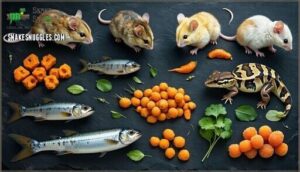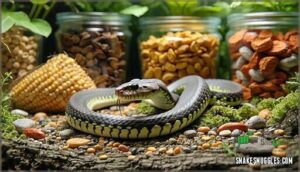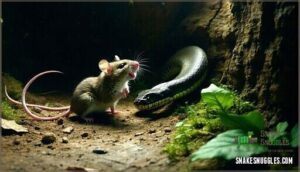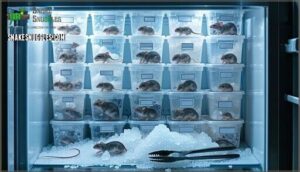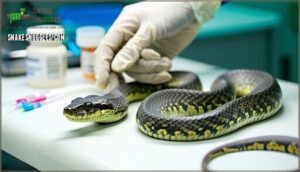This site is supported by our readers. We may earn a commission, at no cost to you, if you purchase through links.
 If you think feeding a pet snake is as simple as tossing in a mouse, you’re missing the bigger picture. Behind every healthy reptile is a careful balance of nutrients, prey selection, and environmental factors that can make or break their well-being.
If you think feeding a pet snake is as simple as tossing in a mouse, you’re missing the bigger picture. Behind every healthy reptile is a careful balance of nutrients, prey selection, and environmental factors that can make or break their well-being.
Snakes have their own quirks—some refuse food for weeks, others demand a precise prey size, and all rely on a diet that promotes bone growth, digestion, and energy.
Whether you’re wrangling a ball python or a corn snake, mastering the snake diet guide means understanding what fuels their wild instincts and keeps them thriving in captivity.
Table Of Contents
- What Do Snakes Eat
- Essential Nutrients for Snakes
- Safe and Unsafe Foods for Snakes
- Proper Feeding Techniques and Schedules
- Creating a Balanced Snake Diet Plan
- Recognizing and Addressing Nutritional Deficiencies
- Dietary Needs of Different Snake Species
- Snake Hunting and Feeding Mechanisms
- Environmental Factors Affecting Snake Nutrition
- Monitoring and Maintaining Healthy Snake Nutrition
- Frequently Asked Questions (FAQs)
- Should I Feed my snake?
- How do you get a snake to eat?
- What do snakes eat?
- What is a juvenile snake diet?
- What are the best practices for feeding pet snakes?
- Is the snake diet a healthy choice?
- What should a pet snake eat?
- Can a snake diet help you eat less food?
- What is a healthy snake nutrition guide?
- How often do snakes eat?
- Conclusion
What Do Snakes Eat
Your snake’s menu isn’t one-size-fits-all—it depends on species, size, and hunting style. From fuzzy mice to quail eggs, different snakes need different prey to thrive.
Let’s break down what belongs in your snake’s bowl and what you should skip entirely.
Types of Prey
In the wild, snakes don’t browse a menu—they hunt whatever crosses their path, and that prey list is surprisingly diverse. Most captive snakes thrive on rodents like mice and rats, but wild diets include birds, reptiles, amphibians, and insects. Frozen-thawed prey delivers whole prey nutrition without the danger of live feeding.
Common prey options include:
- Rodent variety: Mice, rats, and other small mammals form the backbone of most snake diets
- Bird options: Eggs and chicks appeal to species like rat snakes
- Amphibian meals: Frogs and salamanders satisfy garter snakes and water snakes
Prey Size and Type Selection
Knowing what to feed your snake is only half the battle—getting the size and type right determines whether your pet thrives or struggles with every meal. Here’s how to nail prey selection:
- Match prey width to your snake’s thickest body point—rodents or mice should create a slight bulge without overstretching
- Rotate frozen-thawed prey types (rats, mice, chicks) for varied nutritional profiles and to prevent dietary boredom
- Source ethically-raised prey and learn safe practices—proper thawing preserves nutrition and stimulates your snake’s feeding response
Getting size guidelines right transforms your snake diet from guesswork into a science you can master.
Dietary Variations Among Species
Your snake’s species determines its prey choices more than you might think. A wide-ranging database tracking 882 snake species reveals stunning dietary diversity—some lineages hunt up to 17 different prey types, while specialists like Storeria occipitomaculata focus 90% on slugs. Geographic diets shift dramatically too; tropical populations show less dietary overlap than temperate ones. Ontogenetic shifts matter as well—juveniles consume 45% more invertebrates than adults.
Understanding these patterns helps you replicate natural feeding habits and fosters snake nutrition. Snakes with diverse diets often exhibit more complex venoms, reflecting evolutionary adaptations.
Specialized Diets for Specific Species
Some species break the mold entirely. Egg-eaters like Dasypeltis swallow eggs whole—no teeth needed—while slug specialists crush mollusks with specialized jaws. Arboreal snake diets lean toward birds and lizards, whereas aquatic snake diets favor fish and amphibians. Venomous snake diets generally include small mammals, and insectivore snake diets suit younger or smaller species.
Matching your pet snake’s natural prey aids proper snake nutrition and keeps reptile nutrition on track. To be sure your snake gets all it needs, consider supplementing their diets.
- Egg-eaters: Swallow eggs intact; need calcium-rich alternatives if eggs aren’t available
- Aquatic species: Fish-eaters require thiaminase-free prey to prevent vitamin B1 deficiency
- Arboreal hunters: Birds and lizards replicate natural foraging patterns
- Insectivores: Younger snakes thrive on crickets, roaches, or worms before developing
Essential Nutrients for Snakes
Your snake’s body runs on precise building blocks, and getting them right means the difference between just surviving and actually thriving. Whole prey delivers a complete nutritional package, but understanding what’s inside helps you make smarter feeding choices.
Here’s what your snake needs to stay strong, shed clean, and live its best life.
Calcium and Phosphorus Balance
Think of calcium and phosphorus as your snake’s energetic duo—they need to team up in the right ratio, or your pet’s bones will pay the price. Whole prey naturally delivers the ideal 2:1 calcium-phosphorus ratio your snake needs for rock-solid bone health and smooth organ function. This balance prevents metabolic disorders that plague reptiles fed incomplete diets.
Here’s what proper snake nutrition protects:
- Strong skeletal structure for confident movement
- Perfect shedding cycles without complications
- Prime muscle contraction and nerve signaling
- Healthy reproduction when breeding time arrives
Supplementation risks throwing off this delicate balance—stick with whole frozen-thawed prey for bulletproof reptile nutrition.
Vitamin D3 Importance
Your snake’s body can’t access calcium’s power without vitamin D3—it’s the metabolic key that turns raw nutrition into strong bones and perfect sheds. UVB lighting triggers D3 synthesis naturally, mimicking what wild snakes get from sunlight.
Without it, you’ll see deficiency symptoms like soft jaw bones, kinked spines, or failed sheds—classic metabolic impact from poor reptile nutrition and diet. Whole prey delivers some D3, but supplementation risks creating imbalances if you overdo it.
For bulletproof pet snake nutrition, combine frozen-thawed prey with proper UVB exposure to master this critical aspect of animal nutrition.
Protein Requirements
Protein fuels everything your snake does—from crushing prey to healing damaged tissue after a rough shed. Whole prey delivers complete amino acids that drive muscle growth and metabolic functions—no supplements needed. Frozen-thawed rodents provide prime protein sources with perfect digestion efficiency, preventing protein deficiency that weakens carnivorous reptiles.
Core protein requirements for snake nutrition and health:
- Amino acids from whole prey support tissue repair and immune function
- Muscle growth demands consistent protein from appropriately sized meals
- Digestion efficiency peaks when prey matches your snake’s nutritional needs
- Protein deficiency shows as lethargy, poor sheds, and stunted growth
Trace Minerals
Trace minerals might seem insignificant, but they’re the spark plugs firing up enzyme function and immune support in your snake’s body. Zinc, iron, selenium, and copper from whole prey drive mineral absorption, support reproduction health, and power essential metabolic processes. Without proper trace mineral intake, you’ll spot deficiency symptoms like poor sheds, lethargy, and compromised immune response.
Critical trace minerals supporting snake nutrition and health:
- Enzyme function relies on zinc and copper for digestion and tissue repair
- Immune support strengthens when selenium and iron maintain correct levels
- Reproduction health depends on balanced trace minerals in the snake diet
Safe and Unsafe Foods for Snakes
Feeding your snake the right foods isn’t rocket science, but one wrong choice can derail your pet’s health fast. You need a clear grasp of what’s safe, what’s deadly, and why frozen-thawed prey beats live feeding every time.
Let’s break down the essentials so you can feed with confidence.
Appropriate Prey Animals
Not all prey animals are created equal—some pack the perfect nutritional punch while others fall flat. Your best bets? Rodents like mice and rats deliver complete snake nutrition in one package. Birds work for some species, while smaller snakes thrive on insects or amphibians.
Match prey size to your snake’s girth, source ethically, and gut-load feeders beforehand for maximum nutritional impact.
Toxic and Harmful Food Items
Feeding your snake the wrong foods isn’t just risky—it’s potentially fatal. Understanding toxic and harmful food items protects your snake from serious health complications and keeps snake diet fundamentals on track.
Never offer these dangerous items:
- Toxic plants and fruits: Avocados contain persin, causing severe cardiac issues, while citrus fruits trigger dehydration through excessive acid levels
- Processed foods and additives: Chocolate’s theobromine is fatally toxic to reptiles, and high-salt snacks create dangerous electrolyte imbalances
- Wild prey dangers: Fireflies and ladybugs carry lucibufagins that can kill instantly, while wild-caught amphibians often harbor parasites
- Dairy dangers and mold risks: Snakes can’t digest lactose, and moldy foods produce liver-damaging mycotoxins
Stick to screened, appropriate prey for best pet snake care and reptile health.
Risks of Feeding Live Prey
Avoiding toxic foods is just the tip of the iceberg—feeding live prey to your snake poses a laundry list of concerns. Rodents fight back, causing prey injuries like bites and deep scratches that lead to bacterial infections. Live prey also carries parasites that compromise snake health over time.
The stress impact on both predator and prey raises ethical concerns about animal welfare.
Plus, escaped rodents disrupt your snake’s feeding habits and create unnecessary chaos in their environment.
Benefits of Frozen-Thawed Prey
Forget the danger and headaches of live feeding—frozen-thawed prey flips the script on snake nutrition without the drama. You’re getting top-tier safety by eliminating bites and scratches.
Convenience? Stock up on frozen-thawed rodents without weekly pet store runs. Plus, you’re dodging parasites that live prey carries.
This humane approach delivers complete nutrition while protecting your snake’s health—it’s reptile care that actually makes sense.
Proper Feeding Techniques and Schedules
Getting your feeding routine right takes the guesswork out of snake care and keeps your pet healthy. You’ll need to master prey sizing, timing your feeds correctly, and managing food safely.
Here’s what you need to know to feed your snake like a pro.
Determining Appropriate Prey Size
You know that heart-stopping moment when your snake’s eyes are bigger than its stomach—literally? Getting prey width right is non-negotiable. Hatchlings take pinky mice slightly wider than their narrowest point. Juveniles need fuzzy rodents matching mid-body girth. Adults take prey equal to their widest section.
Misjudge this, and you’re risking regurgitation or worse. Snake age and digestive capacity determine growth rates—feed too large, and you’ll learn about snake feeding habits the hard way. Match prey to your snake’s body, not your ambitions.
Feeding Frequency Based on Age and Species
Once you’ve nailed prey size, timing those meals becomes your next power move—and snake age rewrites every feeding rule you thought you knew. Hatchling feeding demands weekly meals to fuel explosive growth. Juvenile schedules shift to every 7-10 days as they mature. Adult intervals stretch to bi-weekly or monthly depending on species variations. Breeding frequency throws another curveball—gravid females need adjusted feeding schedules.
Snake feeding habits vary wildly across snake species, so match your snake diet to their life stage and natural requirements.
Here’s your feeding frequency breakdown:
- Hatchlings and juveniles: Weekly meals support rapid development and metabolic demands
- Adults: Every 10-14 days for most pet snakes, with larger species going monthly
- Breeding seasons: Reduce frequency before and during reproduction cycles
Handling and Presentation of Food
Drop the prey in front of your snake and watch instinct take over—but the moment between thawing and striking separates safe feeding from risky mistakes. Warm frozen-thawed prey to body temperature—lukewarm water works—to trigger feeding response. Scenting prey with chicken broth solves food refusal fast.
Tong feeding keeps your hands safe and teaches your snake proper presentation methods. Never microwave prey; uneven heating burns mouths. Master these snake feeding techniques and your snake diet stays on track.
Post-feeding Care and Monitoring
Your snake just swallowed its meal whole—now the real work begins, and what happens in the next 48 hours determines whether digestion runs smoothly or turns into a regurgitation disaster. Leave your snake alone for at least 48 hours—touching disrupts digestion duration and triggers regurgitation signs like undigested prey.
Watch for behavior changes: lethargy is normal, but restlessness signals problems. Fresh water aids hydration monitoring throughout the shedding cycle, keeping snake health and reptile care on point.
Creating a Balanced Snake Diet Plan
You won’t master snake nutrition by feeding the same thing every week. A balanced diet plan requires understanding which prey types deliver what nutrients, when to adjust portions seasonally, and how to match food choices to your snake’s specific needs.
Here’s how to build a feeding strategy that keeps your snake thriving year-round.
Variety in Prey Selection
Rotating prey types isn’t just good practice—it’s the closest you’ll get to replicating the unpredictable buffet your snake would encounter in the wild. Dietary rotation between mice, rats, and even chicks covers different prey nutritional profiles, enriching snake diets with varied textures and nutrients.
This approach fosters complete nutrition while keeping feeding habits sharp. Novel prey options—ethically sourced, of course—challenge your snake’s instincts and prevent the boredom of a monotonous menu. Smart prey selection means you’re not just feeding; you’re fueling natural behaviors that keep your snake thriving.
Nutritional Value of Different Prey Types
Not all prey is created equal—and knowing the numbers behind each meal type transforms guesswork into strategic feeding. Prey energy density matters: rats deliver 5.00 kcal per gram, mice 4.73, and chicks 5.22. But calcium phosphorus ratio seals the deal, with all three hitting that critical 1–2:1 ideal range for complete nutrition.
Here’s where things get interesting:
- Protein digestibility stays above 90% across rodents and non-mammalian prey
- Micronutrient variation means mice pack more zinc and iron than chicks
- Diversifying prevents deficiencies you won’t see coming
Master the snake diet breakdown, and you’re not just feeding—you’re optimizing.
Seasonal Dietary Adjustments
When temperatures drop and daylight shrinks, your snake’s metabolism shifts gears—and so should your feeding plan. Winter brumation slows digestion, so cut feeding frequency by half or pause entirely. Summer appetite spikes with higher temperatures—capitalize on this for growth and breeding season prep.
During shedding, skip meals to avoid regurgitation, then resume once skin clears. Temperature effects dictate everything: match your snake feeding guide to the thermometer, not the calendar, for prime reptile nutrition.
Meeting Specific Nutritional Needs
Fine-tuning your snake’s diet isn’t one-size-fits-all—it’s about matching nutrition to your snake’s unique demands. Here’s how to dial in reptile nutrition for peak snake health:
- Prey gut-loading enriches nutritional value before feeding
- Dietary rotation prevents deficiencies through varied specialized prey
- Supplement strategies target calcium gaps in animal nutrition
- Hydration sources come from prey tissues, not water bowls
Breeding females need extra calcium—skip that, and you’re risking egg-binding disasters.
Recognizing and Addressing Nutritional Deficiencies
Your snake’s health hinges on getting nutrition right, and problems can sneak up fast if you’re not watching for warning signs. Malnutrition doesn’t always announce itself with dramatic symptoms—sometimes it’s subtle changes in behavior, appearance, or growth patterns.
Here’s what you need to watch for and how to fix it before small issues become big problems.
Signs of Malnutrition in Snakes
Catching malnutrition early can mean the difference between a quick fix and a serious health crisis. Watch for these red flags that signal your snake’s dietary needs aren’t being met:
- Lethargy and reduced activity levels
- Weight loss or muscle atrophy along the spine
- Poor shedding with retained skin patches
- Dull eyes and skin problems
- Stunted growth in younger snakes
These snake health warning signs point to gaps in reptile nutrition and health that demand immediate attention.
Common Vitamin and Mineral Deficiencies
Nutritional deficiencies can derail even the best snake care intentions. Thiamine deficiency strikes fish-eating snakes hard, causing neurological symptoms like rolling over and losing coordination. Vitamin D3 shortfalls weaken bones, while improper calcium ratios lead to metabolic bone disease. Vitamin E deficiency shows up as inflammation, particularly in snakes fed frozen fish long-term. Vitamin C issues are rare but cause fragile skin and tearing.
Understanding these dietary needs protects your snake’s health and wellness.
Overfeeding and Obesity Issues
Too much of a good thing becomes a problem when your snake starts looking more like a sausage than a sleek predator. Obesity indicators include visible fat rolls between scales, a rounded body shape, and difficulty moving. These health complications stem from feeding frequency that’s too aggressive or prey size that exceeds appropriate ratios. Your snake’s metabolic rate can’t cope with constant overfeeding, leading to poor pet health and shortened lifespans. Overweight snakes face respiratory issues, liver disease, and reproductive problems that compromise snake health long-term.
- Monitor your snake’s body condition weekly for early obesity detection
- Adjust feeding habits by reducing meal frequency rather than prey size
- Space out feedings based on your snake’s age and activity level to support proper snake diet and nutrition
Corrective Dietary Measures
Fixing the damage from overfeeding isn’t about slashing calories overnight—it’s about recalibrating your approach with precision and patience.
Extend feeding intervals gradually to avoid refeeding syndrome while monitoring body condition weekly. Adjust your calcium-phosphorus ratio through proper prey selection, and confirm hydration techniques support kidney function.
During dietary shift, use appetite stimulation methods sparingly—your snake’s metabolism needs time to recalibrate for peak animal health.
Dietary Needs of Different Snake Species
Not all snakes eat the same way, and understanding your species’ specific needs gives you the power to feed with confidence. Some snakes need weekly meals while others can go months between feedings—and getting this right prevents both malnutrition and obesity.
Let’s break down what makes each snake unique so you can master their care.
Carnivorous Nature of Snakes
Every snake on Earth is a strict carnivore—there’s no such thing as a vegetarian serpent. These obligate carnivores evolved over millions of years to hunt, kill, and consume whole prey. Their digestive systems can’t process plant matter—only meat delivers the protein and nutrients they need.
Every snake is a natural-born carnivore, evolved to survive solely on whole animal prey—not plants
Whether your snake specializes in rodents, birds, fish, or even other reptiles, understanding their prey specialization and natural hunting strategies helps you nail their nutritional needs and feeding habits in captivity.
Feeding Frequency Variations
Your snake’s meal schedule isn’t one-size-fits-all—it shifts dramatically based on where they’re in life. Age-based frequency matters most: hatchlings need weekly meals to fuel explosive growth, while adults thrive on biweekly or monthly feeds. Species-specific schedules vary wildly—garter snakes eat more often than ball pythons due to faster metabolisms.
Here’s how to nail your feeding schedule:
- Hatchlings (0-12 months): Feed every 5-7 days for best growth
- Juveniles (1-3 years): Move to 7-10 day intervals as metabolism stabilizes
- Adults (3+ years): Feed every 10-30 days based on species and activity
- Breeding females: Increase frequency during reproductive seasons for health impact
Watch your snake’s body condition—individual needs trump generic charts every time.
Snake Hunting and Feeding Mechanisms
Understanding how snakes hunt and eat helps you feed them properly in captivity. Your snake’s wild instincts shape everything from prey selection to digestion timing.
Let’s break down the three key mechanisms that power your snake’s feeding process.
Heat-Sensing Organs
Some snakes hunt by touch and smell alone, but others have evolved something far more powerful—the ability to see heat itself. Pit vipers and pythons use specialized heat-sensing organs—pit organs—that detect infrared radiation from warm-blooded prey.
These organs work like thermal imaging cameras, detecting temperature changes as small as 0.003°C. This infrared detection range gives them pinpoint prey targeting accuracy in complete darkness, offering massive evolutionary advantages for nocturnal feeding techniques and environmental adaptation.
Venomous Snakes
When a venomous snake strikes, it’s delivering a biochemical weapon fine-tuned over millions of years—but for captive snakes, that hunting prowess becomes irrelevant when you’re feeding frozen-thawed prey. Understanding venom potency and delivery helps you appreciate why frozen meals are safer for both you and your snake.
- Venom research reveals neurotoxic and hemotoxic variations affecting prey selection
- Envenomation symptoms include paralysis and tissue damage in wild prey
- Antivenom efficacy matters for keepers, though bites are preventable
- Snake eating habits shift completely when carnivorous diet needs are met safely
Digestion Process
Snakes pack a serious digestive punch that puts your kitchen appliances to shame. After swallowing prey whole, their stomach pH crashes from 7.5 to a scorching 1.5 within hours—that’s gastric acidity rivaling car battery acid. Enzyme secretion kicks in as pepsin floods the gut, dissolving skin, flesh, and even bones over 3 to 5 days of digestion for average meals.
Here’s the metabolic breakdown:
| Digestion Phase | What Happens |
|---|---|
| 0-24 hours | Metabolic rate spikes 3-5x; protein breakdown peaks |
| 24-54 hours | Lipid oxidation maxes out; gut adaptations double intestinal mass |
| 3-5 days | Most nutrients absorbed; keratin (hair, claws) exits undigested |
| 5-14 days | Metabolism normalizes; digestive organs shrink back |
| Large prey | Process extends to weeks; temperature dictates speed |
This feeding habit showcases snake behavior at its finest—approximately 42% of meal energy fuels the digestion itself, making snake diet and nutrition wildly efficient compared to mammals.
Environmental Factors Affecting Snake Nutrition
Your snake’s environment isn’t just about aesthetics—it directly shapes how well they digest food and absorb nutrients. Temperature, humidity, lighting, and stress levels all play important roles in your snake’s ability to thrive on even the best diet. Here’s what you need to get right.
Temperature and Digestion Relationship
If your snake’s metabolism ran on coffee instead of warmth, you’d need to brew a fresh pot after every meal—that’s how tightly temperature controls their digestion. As cold-blooded reptiles, snakes depend entirely on external heat for thermoregulation needs.
Here’s what you need to know:
- Ideal temperature (usually 78-88°F) directly affects digestion rate and snake eating habits
- Heating methods like under-tank heaters or ceramic bulbs maintain consistent ambient impact
- Temperature drops slow enzyme activity, compromising snake diet and nutrition
Master this, and you’ll achieve better snake health and animal feeding success.
Humidity Impact on Hydration
While temperature runs the metabolic engine, humidity determines whether your snake stays properly hydrated without ever touching its water bowl. Snakes absorb moisture through their skin, making humidity levels essential for reptile care. Low humidity triggers dehydration signs like sunken eyes and retained shed, while proper moisture promotes respiratory health and smooth shedding frequency.
Here’s how humidity impacts snake health:
- Water absorption occurs through skin contact with humid air
- Shedding frequency improves when humidity stays ideal for your species
- Respiratory health depends on balanced moisture—too dry causes stress
- Dehydration signs appear quickly in improper environments
- Pet snake care and maintenance becomes easier with consistent monitoring
Master humidity control for excellent animal health and wellness in your snake care routine.
Lighting and Vitamin D3 Synthesis
Proper lighting does more than create ambiance—it fuels critical biological processes. UVB intensity triggers D3 absorption through your snake’s skin, converting cholesterol into vitamin D3 for calcium metabolism. Without adequate UVB exposure, basking behavior won’t deliver the health benefits needed for MBD prevention.
Wild snakes reach UV indices between 0.35 and 3.1 through natural basking behavior, so replicate this light spectrum in captivity. Position UVB lamps near heat sources—your snake fulfills thermal and nutritional needs simultaneously.
Even nocturnal species benefit from ambient exposure, making proper reptile care and exotic pet care essential for animal health and wellness. This approach bolsters animal nutrition through natural pet care practices.
Stress Factors Influencing Appetite
Stress doesn’t just mess with human appetites—it shuts down feeding responses in snakes too. When your pet snake faces Enclosure Stressors or Interaction Impact, their survival instincts kick in—eating becomes secondary to perceived threats. During a Shedding Cycle or Brumation Effects, appetite naturally drops as energy redirects to these processes. Social Stress from cage mates or nearby predators (including other household pets) can also trigger food refusal, affecting snake behavior and snake health.
Watch for these appetite killers in snake care:
- Frequent touching disrupting routine
- Temperature fluctuations slowing digestion
- Inadequate hiding spots creating anxiety
- Bright lighting during rest periods
- Overcrowded enclosures triggering territorial responses
Understanding animal behavior helps you spot when stress—not illness—causes your pet snake to skip meals.
Monitoring and Maintaining Healthy Snake Nutrition
You can’t just throw food at your snake and hope for the best—tracking what’s working matters. Keeping tabs on your snake’s weight, waste, and overall condition helps you spot problems before they spiral.
Here’s how to stay on top of your snake’s nutritional health and adjust as they grow.
Regular Weight Checks and Body Condition Scoring
Tracking your snake’s weight is good practice—it’s how you catch problems before they spiral out of control. Weigh your pet snake monthly on a digital scale to spot weight trend analysis patterns early.
Body condition scoring methods involve feeling the spine and ribs—you want a rounded, triangular cross-section, not bony ridges or rolls of fat.
Growth rate monitoring helps identify obesity risk factors or anorexia early signs before they become serious. This simple animal husbandry habit keeps your snake care on point and your animal nutrition dialed in perfectly.
Fecal Examination for Nutritional Assessment
Nobody likes talking about snake poop, but it’s one of the smartest diagnostic moves you can make. Fecal nutrient analysis reveals digestion efficiency and gut microbiome health at a glance. Check for parasite presence, undigested food particles, or unusual color changes.
Reptile vets can run tests to catch nutritional gaps before they wreck your snake’s health. This simple animal husbandry practice strengthens your animal nutrition game and keeps snake health and wellness locked in.
Blood Work for Nutritional Imbalances
Peek behind the curtain of snake health, and blood work reveals the real story. Reptile vets track nutritional needs by measuring:
- Calcium imbalances and phosphorus ratios—red flags for bone and kidney issues.
- Uric acid and protein levels—clues to hydration, renal health, and animal feeding habits.
- Electrolyte changes—signals of metabolic trouble.
With these numbers, you don’t just guess. You spot problems early, adjust diets, and keep snake health and wellness on point—no surprises, just mastery.
Adjusting Diets as Snakes Age
As your snake shifts from spring chicken to seasoned veteran, its metabolism doesn’t just slow down—it practically rewrites the rulebook. Growth stage dictates everything: hatchlings wolf down frozen-thawed prey weekly, juveniles stretch to 10 days, and adults cruise at two weeks.
Breeding diets demand extra calcium-phosphorus ratio precision, while geriatric needs call for smaller meals and supplement timing adjustments.
Track metabolic shifts by watching body condition—your snake’s shape tells you when to dial back portion size or frequency. Complete nutrition means adapting animal feeding strategies as pet snakes age, not forcing yesterday’s menu on today’s reptile.
Frequently Asked Questions (FAQs)
Should I Feed my snake?
Like clockwork, your pet snakes need feeding based on their age and size. Stick to whole prey, choosing frozenthawed options for safety.
Feeding frequency and prey size matter—skip live feeding to guarantee complete nutrition and stress-free meals.
How do you get a snake to eat?
Getting a snake to eat often means tweaking environmental factors, scenting prey, or using assist-feeding techniques.
Stimulating appetite with proper prey selection and feeding techniques—especially frozenthawed prey—helps address refusal and keeps snake feeding on track.
What do snakes eat?
Don’t believe the myth—your snake isn’t stuck eating just mice. Prey diversity is key. Their wild diets include rodents, birds, reptiles, and even insects. Feeding adaptations let them tackle anything that meets their nutritional needs and feeding habits.
What is a juvenile snake diet?
A juvenile snake diet focuses on frequent feedings, small prey size, and proper hydration methods. Growth rate drives feeding frequency, with rodents as the mainstay.
Supplementation needs are minimal if you’re feeding whole prey, supporting healthy growth in pet snakes.
What are the best practices for feeding pet snakes?
Think of feeding snakes as orchestrating a symphony—prey thawing is essential, feeding frequency matters, and care techniques must be gentle.
Prioritize frozen-thawed rodents, monitor snake hydration, and evaluate supplementation needs for best Reptile Care and Management.
Is the snake diet a healthy choice?
Choosing a snake diet for yourself isn’t healthy—these reptiles thrive on Dietary Completeness from whole prey, not plant foods.
Nutritional Adequacy for humans requires Prey Diversity and different Health Indicators, so stick to balanced human nutrition.
What should a pet snake eat?
You know what they say—“you’re what you eat.” For pet snakes, that means frozen-thawed rodents or quail, sized to match your snake.
Prey variety promotes nutritional balance, while a consistent feeding schedule keeps feeding habits healthy.
Can a snake diet help you eat less food?
A “Snake Diet” mimics snake feeding habits by promoting calorie restriction and infrequent meals. You might eat less, but snake diet risks include nutrient deficiencies and unsustainable satiety.
Evolutionary diet insights suggest pet snakes thrive on balanced, carnivorous nutrition.
What is a healthy snake nutrition guide?
A balanced snake diet means offering whole prey—like mice or rats—matched to your pet’s size. Vary prey item variety, watch for nutritional deficiency signs, prioritize safe feeding practices, and remember hydration is key for healthy, thriving pet snakes.
How often do snakes eat?
You won’t see pet snakes eating daily. Age-based frequency matters—young snakes eat more often, while adults may wait weeks.
Species-specific needs, seasonal variations, digestion rates, and prey size all shape Snake Feeding and Nutrition schedules.
Conclusion
Think of feeding your snake as setting the stage for a quiet symphony—each prey item, nutrient, and environmental tweak plays its part behind the curtain. The snake diet guide isn’t just a checklist; it’s your script for keeping instincts sharp and bodies resilient.
When you respect their quirks and invest in balanced nutrition, your snake’s health becomes less of a gamble and more of a guarantee. That’s how you turn care into mastery—one thoughtful meal at a time.
- https://www.revivewellness.ca/blog/the-snake-diet-reviewed-by-a-dietitian/
- https://www.getlabtest.com/news/post/snake-diet-risks-effectiveness-safety
- https://www.cancerwellness.org/blog-cancer-wellness-center-sets-the-record-straight/
- https://www.transparentlabs.com/blogs/all/snake-diet
- https://pmc.ncbi.nlm.nih.gov/articles/PMC6314618/

